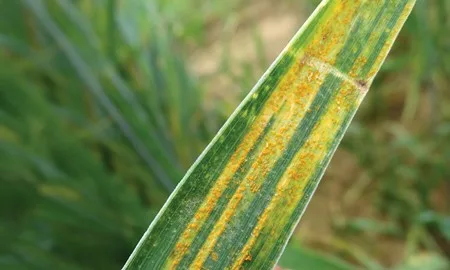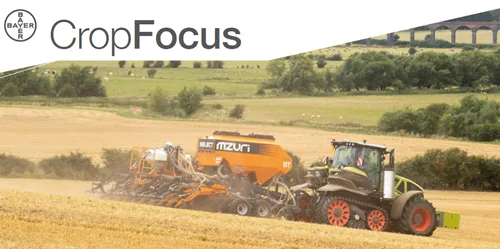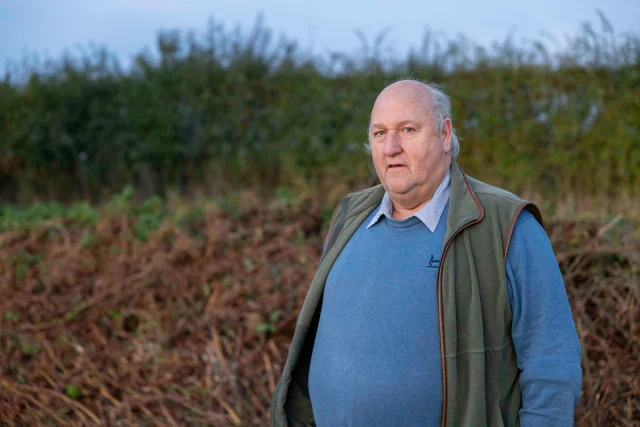Published on 1st February 2023
Disease Management
Learning Lessons From Yellow Rust

• Weather was a key driver of late yellow rust in 2022
• Potential for temperature tolerant strains to develop in future
• Fungicides still perform well – Prothioconazole loading is key
• Combine chemical and cultural controls (e.g. varietal resistance)
What we can learn from Yellow Rust
During June 2021, Septoria came almost out of the blue. Until then, CropCheck Septoria scores had been low, apart from in the most susceptible varieties, but the disease took off in warm, wet weather before the Cereals event.
Last season was almost a carbon copy, although this time CropCheck scores provided early warning of rapidly rising yellow rust DNA.
The disease was virtually absent during the first quarter of 2022, with CropCheck scores all below 20 – the protectant phase.
It was not until April significant latent infection was found, on leaf 5 of RGT Saki at Scoughall Farm, East Lothian. As the season progressed, latent infection was found at other sites and varieties in Lincolnshire and Perthshire, again restricted to lower leaves.
As June opened, disease jumped, with more cases elsewhere, including in KWS Extase at Fawley Court, Herefordshire.
A variety thought to be highly resistant to all strains except 19/215. Skyfall at Malshanger Estate, Hampshire had seen little yellow rust all season, but it appeared in the top two leaves “out of nowhere” noted manager, Ian Margettes, and Bayer’s Richard Prankerd.
What caused this late burst?
The weather played a part. Met Office figures show February to May were warmer than average, and particularly conducive at 10-20°C for most areas.
As temperatures increased into summer, it took time before CropCheck yellow rust scores abated – despite research suggesting temperatures above 20°C should check the disease raising questions of whether new strains are circulating.
NIAB’s Dr Aoife O’ Driscoll says fitness is a question of survival and reproduction. “We know the current Warrior population has a shorter time from infection to sporulation. This race produces more spores, including black telia later in the season.
“However, the correct crop and climatic conditions are needed for yellow rust to
survive, reproduce and cycle faster. Cool to very warm sunny days, with cool, still, dewy nights are most important to its development. If conditions are right, yellow rust could cycle faster.”
ADAS research scientist Chloe Morgan says talk of higher temperature strains isn’t new, but the fact they have not yet dominated the population could suggest a fitness penalty in these strains.
She agrees more warm springs and summers could further select for temperature-tolerant isolates, raising concerns about whether late yellow rust infections carry a greater recombinant risk that could lead to novel genotypes.
Dr O’ Driscoll thinks it is possible, however recombination risk is still low. While some later yellow rust infections are being found with black telia, this isn’t yet increasing recombination risk, due to the requirement of a secondary host, barberry.
The disease requires this herbaceous shrub to complete its sexual reproductive stage, but fortunately there is currently low levels of barberry in the UK. However, some managed plantings are occurring to encourage the endangered Barberry Carpet Moth. Barberry also hosts stem rust, which has increased in the UK, so may require close monitoring in future.
Ms Morgan believes fungicides applied at GS 39 usually have sufficient activity against late season yellow rust, despite the Septoria focus.
“T2 programmes tend to be quite robust with a minimum of two actives, and most actives provide good yellow rust control, even in high pressure locations and susceptible varieties.”
Bayer’s Greg Hanna says reduced yellow rust activity at T2 could accelerate the emergence of recombinant strains and adds that last season yellow rust activity was welcome at T3. Should some strains become more temperature tolerant, a stronger foliar presence might be required for future ear sprays.
However, he also says the disease is still well controlled by many fungicides. The problem is where compromise occurs, always possible given weather volatility.
This happened at Ovington Hall, Essex, where James Nott says late yellow rust pressure was intense last year. High winds curtailed some T3 applications and the disease quickly appeared in Gleam, but where ear sprays were applied in good time, disease was kept in check.
Complementary actives combine
Strong fungicide performance was also seen in a high-pressure yellow rust T1 trial at Troston Farms, Suffolk, with Skyfall. Several products performed well, especially those with robust doses of prothioconazole.
“Where we lifted the rate of prothioconazole from 130 to 156 g/ha, we saw a 0.5 t/ha yield response,” notes Mr Hanna.
That was seen in comparisons of two stand-out products, Ascra (prothioconazole + bixafen + fluopyram) and Elatus® (prothioconazole + benzovindiflupyr). Applying 0.8 L/ha of
Elatus® and 1.0 L/ha of Ascra delivered 9 t/ha, but increasing the Ascra rate to 1.2 L/ha raised that to 9.46 t/ha.
Mr Hanna says T1 prothioconazole loading is key to bridging the gap to T2.
“Products and mixtures applied at rates delivering over 150 g of prothioconazole delivered excellent performance, even in highly susceptible varieties under high disease pressure. It is why we recommend Ascra at 1.2 L/ha where curative yellow rust activity is required.”
At Troston Farms, regular qPCR testing confirmed the disease was well into its latent phase on leaves 5 and 4. That Ascra delivers persistence and punch is due to the actives and formulation, says Mr Hanna.
“The actives all work at slightly different speeds and prothioconazole and fluopyram are highly efficacious. Fluopyram is a fast-moving SDHI that gets into the leaf quickly. Prothioconazole is a little slower, so they complement each other neatly. Yellow rust control could be more challenging with the loss of tebuconazole, and growers might need to rely more on varietal resilience".
“But, Ascra is clearly a very good yellow rust protectant, coupled with strong Septoria activity. There isn’t another fungicide that delivers this level of broad-spectrum control.”
Fungicides must be used with cultural measures, including diverse varietal genetics, notes Dr O’ Driscoll, who says around 60% of UK wheat was sown to just six varieties last year, three with yellow rust ratings of 5 or less.
Strong all-rounder is a step closer
Despite our knowledge of disease pathogens, they continue to surprise, whether it be late yellow rust last season, Septoria the season before, or the emergence of the Cougar Septoria strain. All are timely reminders that the best way to avoid unwelcome surprises is by building a comprehensive defence.
While there is an extensive fungicide arsenal available, some options are rather one-dimensional with performance slanted towards Septoria or yellow rust, but not both. Fortunately, in the wings is Iblon (isoflucypram), with registration expected soon.
In several trials, Iblon has been on par with Revysol® and Inatreq® for Septoria activity, and more protective and curative than benzovindiflupyr for yellow and brown rust.
“Ascra is the current broadspectrum fungicide benchmark, but when Iblon comes, it will surpass it,” says Mr Hanna.
Iblon is the next level in all-round fungicide chemistry, consistently delivering comprehensive disease control, he adds.
This is substantiated in various independent T1 and T2 trials. NIAB, Stockbridge Technology Centre, Envirofield, and Oxford Agricultural Trials data all show Iblon delivers yields equal to, or better than, current standards.
Add in Bayer trials at Hinton Waldrist and Callow, and the data set spans more than 30 varieties and several blends.
“This covers an array of varietal agronomic packages,” explains Mr Hanna. “Only a few have good resilience against the full disease spectrum and many have a serious disease susceptibility somewhere. Our variety screens often highlight weaknesses in a particular product or active, but we see Iblon performing well across the board.”
Broad spectrum disease control, including eyespot, clearly drives yield results, but he believes this is enhanced by green leaf retention. Aviator was the first fungicide to carry a greening label; Ascra followed with an expanded list of physiological properties.
Bayer’s research indicates Iblon takes this further, lifting green leaf retention beyond Ascra.
The similarities with Ascra also include formulation properties. Tests demonstrate the same leaf adhesion and coverage, making it rainfast in minutes. That movement partly explains Iblon’s strong Septoria and yellow rust control. “Clearly isoflucypram is highly efficacious
against Septoria and yellow rust, and importantly, it is active throughout their life cycles. Isoflucypram starts working when spores begin to germinate on a leaf through to sporulation.
“But to ensure this, the right balance of leaf coverage and penetration is required, and this is down to the formulation. It provides optimum delivery of chemistry to the leaf surface for excellent droplet adhesion and distribution.
“It’s why Iblon offers effective yellow rust control without compromising Septoria activity.”
Mr Hanna sees Iblon as a versatile fungicide suiting many scenarios throughout the programme.
“It comes down to variety susceptibility and risk. For Skyfall and a yellow rust threat, it lends itself to T1, but for Crusoe and late brown rust, it’s a natural fit for T2, where greening properties can be optimised.
“Ultimately it is a very good broad-spectrum fungicide with numerous added value benefits.”
This article is an extract from CropFocus magazine, if you would like to sign up for the next issue please sign up here

Acknowledgements: Ascra is a trademark of Bayer. AscraXpro contains bixafen, fluopyram and prothioconazole. Revysol is a trademark of BASF. Inatreq is a trademark of Corteva Agriscience. Inatreq active contains fenpicoxamid.



